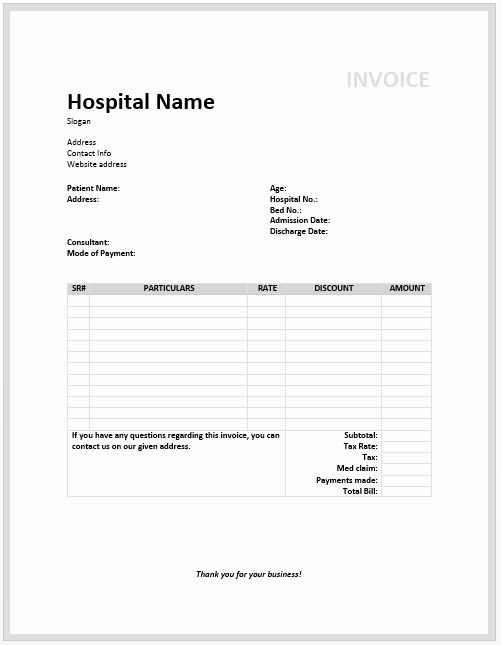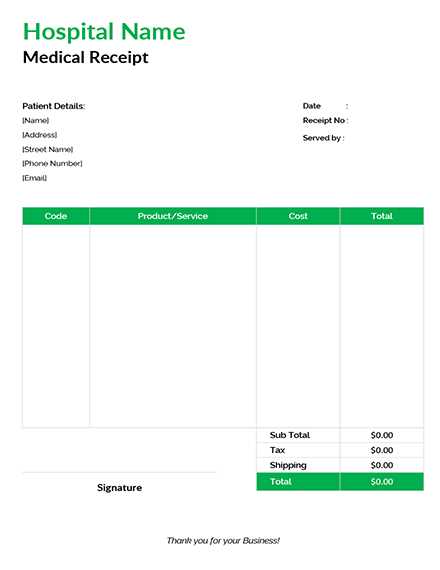
A well-structured hospital receipt should include key details to ensure clarity and accuracy. Start by specifying the hospital name, address, and contact information. This establishes the source of the receipt and provides essential details for future reference.
Include the patient’s full name, date of service, and invoice number. These details help in tracking payments and associating them with specific medical records. If applicable, list the attending physician’s name and department.
Break down the charges into clear sections. Use itemized listings for consultation fees, diagnostic tests, procedures, medications, and any additional services. Indicate the cost for each item and provide a total amount due. If insurance covers a portion, include a section showing the insured amount and the patient’s out-of-pocket expense.
Specify the payment method and transaction details. Whether the payment was made via cash, credit card, or bank transfer, recording the transaction type and reference number enhances transparency. If partial payment was made, note the remaining balance and due date.
Finally, include a thank you message or hospital policy statement regarding refunds, billing inquiries, or future appointments. A signature or stamp from the hospital’s finance department can validate the receipt and provide official confirmation of payment.
Receipt Template for Hospital Billing

Ensure clarity and accuracy by structuring the receipt with essential details. Each receipt should include the hospital’s name, address, and contact information at the top. Clearly label the document as a “Medical Receipt” to avoid confusion.
Key Information to Include
- Patient Details: Full name, patient ID, and contact information.
- Date of Service: The exact date the medical services were provided.
- Breakdown of Charges: List each service separately with corresponding costs.
- Payment Details: Indicate the total amount, payment method, and any outstanding balance.
- Authorized Signature: Include a space for the hospital representative’s signature and stamp.
Formatting Tips
Use a clean, readable font and organize sections logically. Tables can help display charges clearly, making it easier for patients to review their expenses. Digital receipts should be formatted for easy printing while maintaining a professional layout.
Key Components of a Hospital Receipt

Patient Information: Include the patient’s full name, unique identification number, and contact details. Accuracy here ensures proper record-keeping and billing.
Date and Time: Clearly state the date and time of service. This helps with insurance claims, reimbursements, and future reference.
Services Provided: List each service or procedure separately, along with corresponding codes if applicable. Transparency reduces billing disputes.
Itemized Costs: Break down charges for consultations, tests, medications, and any additional fees. A clear cost structure prevents misunderstandings.
Payment Details: Specify the payment method, amount paid, and any outstanding balance. If covered by insurance, include insurer details and claim references.
Hospital Information: Display the hospital’s name, address, contact number, and tax identification number. Official details enhance credibility.
Authorized Signature: Ensure the receipt includes an authorized signature or stamp. This confirms its validity and authenticity.
Formatting Guidelines for Clarity and Accuracy
Use a clear, legible font such as Arial or Times New Roman in 12-point size to ensure readability. Avoid decorative fonts that may reduce clarity.
Consistent Structure

Align text and numerical values properly by using tables or tab stops. Left-align text and right-align numbers for easy scanning. Ensure that spacing is consistent across all sections.
Precise Data Entry

Include only relevant details such as patient name, date, itemized charges, and total amount due. Use a standardized date format (e.g., YYYY-MM-DD) to prevent misinterpretation. Double-check figures to avoid discrepancies.
Ensure all labels are distinct and concise. Use bold text for section headers like “Total Amount” or “Due Date” to make key information stand out.
Customization Options for Different Medical Services
Adjusting hospital receipts for various medical services ensures clarity and compliance with billing standards. Use dynamic fields to tailor each receipt to specific treatments, procedures, and departments.
Service-Specific Details
- Procedure Breakdown: List individual services with itemized costs.
- Department Information: Include department names to streamline internal tracking.
- Specialist Identification: Add attending physician details for patient reference.
Payment and Insurance Adjustments
- Custom Payment Methods: Display cash, credit, or installment options.
- Insurance Processing: Incorporate insurer details and coverage breakdowns.
- Discounts and Adjustments: Highlight eligibility for financial aid or loyalty discounts.
Ensure receipts meet regulatory requirements by including mandatory disclosures. Custom fields simplify adaptation for different services while maintaining consistency in documentation.


